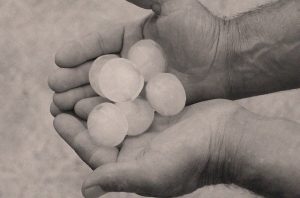By Kathleen Smart – Wetaskiwin, Alta.
As I tossed the second load of wet clothes into my electric clothes dryer on a cold winter morning, I remembered helping mother with her washing all those years ago. Washdays were so labour intensive 75 years ago. Winter made them particularly difficult.
Washday was usually on Monday but in wintertime, preparation began Sunday evening. Mother wanted soft water from melted snow. Dad carried in a copper boiler filled to the top with snow, setting it to the back of the kitchen wood-stove to melt overnight.
On his second trip, he carried a large, hard block of snow cut from a nearby snowdrift, placing it on top of the melting snow in the boiler. After supper, mother would ask my sisters and me to get the soap ready.
We eagerly took turns grating long curls from a cake of creamy-coloured, homemade lye soap into the old blue enamel pot. Some water was added and it too was placed on the back of the stove.
No more washboard scrubbing
As soon as dad lit the kitchen stove Monday morning, he pulled the boiler of melted snow to the front to heat it up. He then went out to milk the cows. After breakfast, dad and mother carried the manual washing machine from the porch into the kitchen.
Mother told us she considered herself fortunate not to still be scrubbing clothes on the washboard she used when first married. The machine was filled with hot water from the boiler and some of the liquid soap was added.
Two metal washtubs were set on a wooden stand in front of the machine. These were for rinsing the clothes. They were filled with cold water. Another pail of cold water was ready to be poured into the copper boiler when all the hot water had been used. It would be pulled over to the hottest part of the stove to boil stained tea towels and the ‘milk cloths’.
Our clothes and household items from the ‘dirty clothes box’ were sorted in piles on the hall floor. The first load of light-coloured items were put into the washing machine.
During holiday times, we children were asked to help. We sat on a high stool beside the washing machine, turning the large wheel to agitate the clothes. It was so monotonous turning the wheel ‘round and ‘round as the clothes were swished through the soapy water.
When mother came to relieve us, she brought her book. Holding it in one hand and reading, she continued to turn the wheel. Obviously, she too found it a monotonous job. Each load was agitated for about 20 minutes.
Blueing cake makes it whiter
Clothes were wrung out through the manual wringer into the first rinse water. They then went into the second rinse, to which a cake of ‘blueing’ had been added. “This little cake of blueing is going to make clothes whiter and brighter,” mother explained. It turned the rinse water a beautiful sky-blue colour and I puzzled over how blue water could make clothes whiter.
Those clothes were wrung out into the laundry basket and another load went into the washtub. Finally, when the last load was wrung out – dad’s heavy, dark blue overalls – the washing was done. Dad emptied the water, carrying pail after pail to be dumped outside. The washing-machine and tubs were returned to the porch, the copper boiler and soap pot taken downstairs. The kitchen was then back to normal.
In springtime clothes drying was easier. All items were hung outside on the six long metal lines with wooden clothes pegs. The prairie breezes and sunshine quickly dried the clothes. Not so in winter, when the drying was a problem.
Light things such as tea towels, were hung over a line above the kitchen stove. The rest and our heavy, long-legged underwear and dad’s overalls, were hung on lines in the basement, slowly drying over several days.
The washing took all morning, but when dad came in for dinner, mother had the meal ready. We girls set out the plates and relaxed around the dinner table. Ironing would be done next day or later in the week. The biggest job, the washing, was finished for another week.



